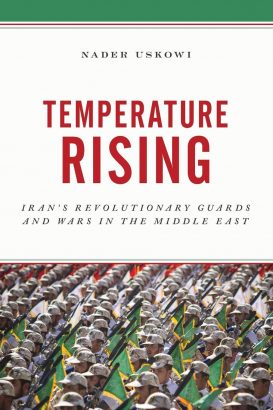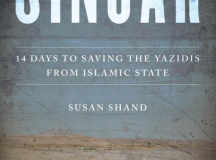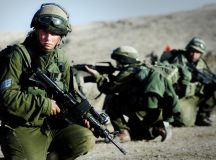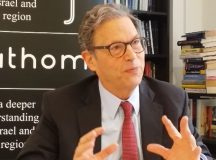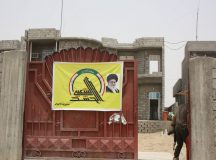Nader Uskowi opens his first book, a concise but definitive account of Iran’s Islamic Revolutionary Guard Corps’ (IRGC) expeditionary activities in the Middle East, recounting a meeting he had with Ayatollah Ruhollah Khomeini in Paris just before the victory of the Iranian Revolution. The future Iranian ruler told Uskowi, then a young journalist, that the Islamic Revolution was not just for Iran but the entire Middle East.
On the 40th anniversary of that revolution, the regime in Tehran has certainly made significant headway in implementing Khomeini’s project. Uskowi’s book documents the activities of the IRGC’s Quds Force, the arm of the organisation responsible for operations beyond Iran’s frontiers. Under the current leadership of Major General Qasem Soleimani, the Quds Force has amassed approximately 200,000 Shiite militiamen under the loose umbrella of the Shia Liberation Army (SLA). The IRGC has used the SLA for manpower to carry out its operations against its various enemies across the region. The most notable example of them doing so was in the final stages of the infamous battle for the Syrian city of Aleppo, which Uskowi demonstrates was largely a Quds Force-directed operation.
While Uskowi’s book is very short it does give plenty of historical context for all of the major theatres in the Middle East the Quds Force is engaged in. Shortly after the revolution, the Islamic Republic got to work training Afghan refugees inside Iran as fighters to overthrow the Soviet-backed regime in Kabul. Then Tehran moved on to establish Hezbollah in Lebanon in 1982. Hezbollah from the get-go was, and is now self-admittedly, a mere proxy of the IRGC, the most successful and powerful it ever created. In Iraq, Uskowi goes into considerable detail about how Iran established Iraqi militias during the Iran-Iraq War, which later amassed immense political power in the country in the post-Saddam Hussein era. Also, links between Iran and the Houthis in Yemen date back to the days of the revolution. Quds Force training and arming of the Houthis was very significant before the Saudi-led coalition’s air and naval blockade on Yemen began in 2015.
Uskowi demonstrates the military acumen of Major General Soleimani over the years but also demonstrates how Iran quickly overstepped its major victories in both Syria and Iraq. After the defeat of the anti-Assad opposition in Syria’s second city Aleppo, for example, a hinge moment in the Syria war which indicated that the opposition had no chance of toppling Syrian President Bashar al-Assad, Soleimani sought to establish permanent bases in Syria. This constituted a red-line for Israel, which responded by carrying out enormous airstrikes targeting all the known IRGC facilities across the country, the two most notable strikes being in February and May 2018, responses to IRGC provocations on both occasions. Uskowi points out that by staying in Syria, and engaging in this project to build bases, establish a new front against its Israeli enemy and improve the accuracy of Hezbollah missiles, the IRGC is risking a major war with Israel, and possibly the United States too, that it will unlikely win.
In Iraq, after militias under its command contributed hugely to the rollback of the Islamic State group there, Tehran overplayed its hand in late 2017. The Quds Force orchestrated the Iraqi takeover of Kirkuk from the Iraqi Kurdistan region shortly after that autonomous region’s independence referendum. Its forces then entered the Iraqi border town of Al-Qaim shortly before its SLA proxies entered the Syrian town of Abu Kamal just over the border, an apt indicator of Iran’s regional reach via proxies across both countries. However, by strutting its forces around Iraq the way it did, through the open use of militia proxies and its infiltration of the governmental institutions, the Quds Force quickly divided Iraq’s Shia majority population. ‘Heavy-handed tactics to influence the country’s security and other government institutions by Soleimani and his men in Baghdad had come back to haunt them,’ Uskowi writes. ‘It would be painful for Iraqis, Shia or not, to see a foreign power practically controlling their country.’ Iraqis demonstrated their true feelings just six months later in the elections when they voted for Muqtada al-Sadr’s list, who used nationalist rhetoric in his campaign, with Hadi al-Amiri, a close ally of Iran who has done Tehran’s bidding in Iraq for decades, coming in second. Those results were a clear indication of just how divided Iraqis really are about the role Iran plays in their country.
While Tehran has, through the IRGC and SLA, exerted enormous influence and control over Baghdad, Beirut, Damascus and Sanaa respectively, Kabul was the one capital it never had any real control over. Uskowi gives us a history of Iran-trained Afghans from the 1980s until the present. He recalls the early days during the American war in Afghanistan shortly after the 11 September 2001, terrorist attacks, when they briefly coordinated through the Northern Alliance against the Taliban. The liberation of Herat, a city near the Iranian border, from Taliban rule in late 2001 was also coordinated between the two. In more recent years, however, Tehran has lent support to its former Taliban adversary in Afghanistan in order to put pressure on the American troop presence there.
Yemen serves as a noteworthy case because it shows the shortcomings of the broader IRGC regional strategy. Uskowi shines some light on the land bridge that Tehran established running through Iraq and Syria right up into Lebanon. This vital conduit enables Iran to bolster and rearm Hezbollah even if its air route from Tehran to Damascus or Beirut is blocked. In the case of their Houthi allies in Yemen, however, the minute the Saudis and Emiratis blockaded the country’s seaports and bombed runways across the country there was little Iran could do to resupply the Houthis. Lack of a land-bridge and a friendly regime to host its forces in the country showcased how fundamentally limited the IRGC’s ability to project power can be in the region.
Furthermore, Uskowi warns that the IRGC/SLA activities could have sparked a major war. Iran’s arming of the Houthis, who have used ballistic missiles against Saudi Arabia that have even targeted the royal palace and airport in Riyadh, ran the risks of sparking a direct confrontation between the two, in which the US could quickly have become involved on the side of Riyadh. Its aforementioned confrontations with Israel in Syria could also lead to a wider war that Iran would also likely lose. He points out how these cases violate the IRGC’s own doctrine of fighting its proxy wars in the grey area, hence ‘a state between war and peace, of limited military action and not inviting conflicts with superior forces.’
Uskowi outlines how the IRGC controls ‘a dozen mega foundations, which in turn control more than five hundred business enterprises, together accounting for nearly half of the Iranian economy’.
The latest economic downturn in Iran has seen the value of the national currency decline to historic lows and economic stagnation. In recent years a slowdown that has affected businesses has also hit the IRGC’s ability to generate revenues to fund their numerous extraterritorial projects. Furthermore, Iran has recently seen its worst protests nationwide in the last decade. These protesters have demanded, among other things, that Tehran ‘allocate funds spent in the near abroad on improving the economy at home’.
‘Such sentiments at times of economic hardship, high unemployment, and rising costs for basic goods like food could undermine the Quds Force’s expectation of public support for its projects abroad,’ Uskowi noted.
The author briefly revisits his meeting with Khomeini in his short conclusion and offers the reader some of his own speculation about what the Islamic Republic’s founder would do today. He believes that Khomeini would have concluded that Iran has overplayed its hand and overextended in the region and would draw down accordingly. ‘If the ayatollah could see modern Iran, he would caution us against a literal interpretation of what he had said,’ back in 1979, Uskowi reasons. ‘Yes, the revolution was about the region, but an isolated Iran could not advance the cause.’ He reinforces this case by pointing out that Khomeini agreed to a ceasefire with Iraq following eight years of war after previously promising ‘total victory’ over Baghdad.
Another part of Uskowi’s analysis that’s very important for consideration is his warning of what could happen to the 200,000 committed fighters that make up the SLA should the IRGC not continue to sustain and fund them. If they were ever demobilised, he warns, they could use the know-how and training they got from Tehran to continue causing trouble in their respective countries or beyond. Uskowi also points out that if the regime in Tehran did fall, the SLA and the Quds Force could still operate in the region since they possess ‘a vast network of associates and supporters across the globe, front businesses, and caches of arms in the region, the Quds forces is organised to last for decades as the defenders of a militant political interpretation of Shia Islam and if necessary to outlast the Islamic Republic itself.’ [Emphasis mine.]
The book’s fundamental shortcoming and flaw is its repetitiveness. Repeated facts and almost identical summaries of events quickly become tedious, especially when one reads large parts of this short book in one sitting. While this does mean that each separate chapter, dealing with each respective SLA group, can be more easily read like a standalone essay, for a book this short the basics are repeated far too many times, often with the same footnotes used again needlessly. Aside from this scruple, Temperatures Rising remains a must-read for anyone who wants to gain some understanding of the IRGC, what it has done throughout the Middle East and what its goals are.

